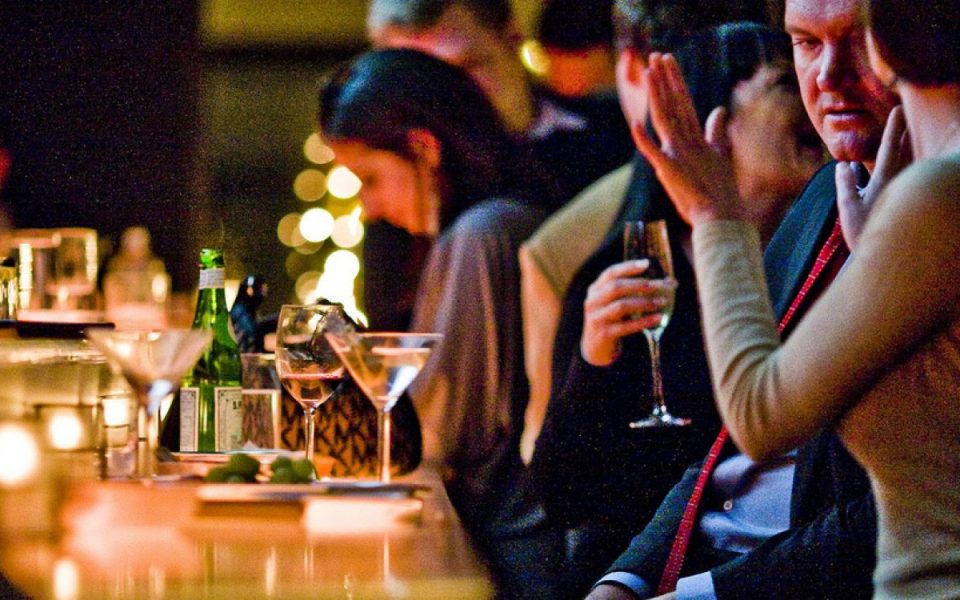
A customer walks in, looking as unsure as anyone I’ve ever
encountered at the bar. It’s strange to me how some people can get
uncomfortable going to a bar by themselves. Maybe I’m just used to the solo approach.
He scans the room, glances at his phone, and scans the room
again. He pauses awkwardly by the door (To dash out if he realizes he’s in the
wrong place?), he sits down at the bar and orders a shot to calm those nerves.
First impressions are a bitch.
A woman enters a side door, and I see his face light up in
partial recognition. Is this her? I think it’s her. He greets her and
I’m taking bets as to whether it will be the businesslike handshake, the
awkward hug (the one where you lean forward, you know the one) or maybe the
no-touch rule comes into play and it’s just tight smiles and pleasantries. The
awkward hug wins. The Art of the First Impression is now in it’s first stage;
they’re both playing it safe.
I remember when people would just come to the bar to hook
up. Now, dating apps take much of the risk out of the game. But still there are
rules and guidelines.
When meeting at a bar, alcohol comes into play. It’s a
casual “no-strings” meeting that provides an easy out in case a connection
isn’t made. The general approach is that first dates order something they can
take their time with. She gets a light cocktail, he gets a beer, they retire to
an isolated booth.
This isn’t a coffee shop in the afternoon, so the rules are
different. But one must be careful, I’ve seen first-time meet-ups fail
spectacularly after one too many. Lips will loosen, ships may sink and the next
thing you know it’s red-flag city.
I recall online dating becoming a thing when I was in
college. It was a clumsy approach to an age-old method, but it had potential.
Used to be, a bartender could make or break a first date. That’s still possible,
of course, but it’s just not the same.
It’s not likely, but maybe those stars will align for these
two today. I’m always happy to see someone come out of their comfort zone and chalk
up a win in the romance department. Part of the job is living vicariously
through your customers.
This “Busy Bar” approach is a common method — the main
advantage being is that it’s easy to get out of there quick if it’s terrible.
You might be a regular and know that the bartender or other customers have your
back. Your friends might be hanging out at the bar next door, waiting for
failure so you can join them after the sparks don’t fly. This happens a lot.
One of the bars I work at is a perfect place for more
intimate encounters. It’s an out-of-the way place, plenty of nooks to nestle
yourself in, the Heliocentrics or some other instrumental ’70s band sets the
mood and nobody is screaming trivia questions into a microphone. It’s a warm,
roomy place with space to move. I’ve got some regulars who pick this spot as a
neutral zone precisely because it’s out of the way and there’s less a chance of
encountering anyone they know. Besides me, of course.
The couple are still talking. I’m optimistic about their
chances. You have to be in this business — it’s very easy to acquire a
pessimistic point of view with so many chances to fail at a bar. So it’s nice
to see something work out.
Body language is everything. I see eye contact, open
postures, smiles. That’s encouraging. I busy myself with other customers, while
letting the courtship play out. A bartender should have the ability to pay
attention without hovering around the customers waiting for a chance to hop on
the next drink. Especially with first encounters. Let them breathe.
I find myself talking to one of my regulars, and as I hear
laughter echo from the booth, I look up and see the guy coming up for another
round. He’s got a dazed expression with a half grin, almost like he’s surprised
that it’s working out. I’m happy for him.
“You doing okay?” I ask. He grins, nods, and hurries back to
the booth, where the woman expectantly waits with a smile on her face.
So far, so good.
Join the First Amendment Society, a membership that goes directly to funding TCB‘s newsroom.
We believe that reporting can save the world.
The TCB First Amendment Society recognizes the vital role of a free, unfettered press with a bundling of local experiences designed to build community, and unique engagements with our newsroom that will help you understand, and shape, local journalism’s critical role in uplifting the people in our cities.
All revenue goes directly into the newsroom as reporters’ salaries and freelance commissions.


Leave a Reply